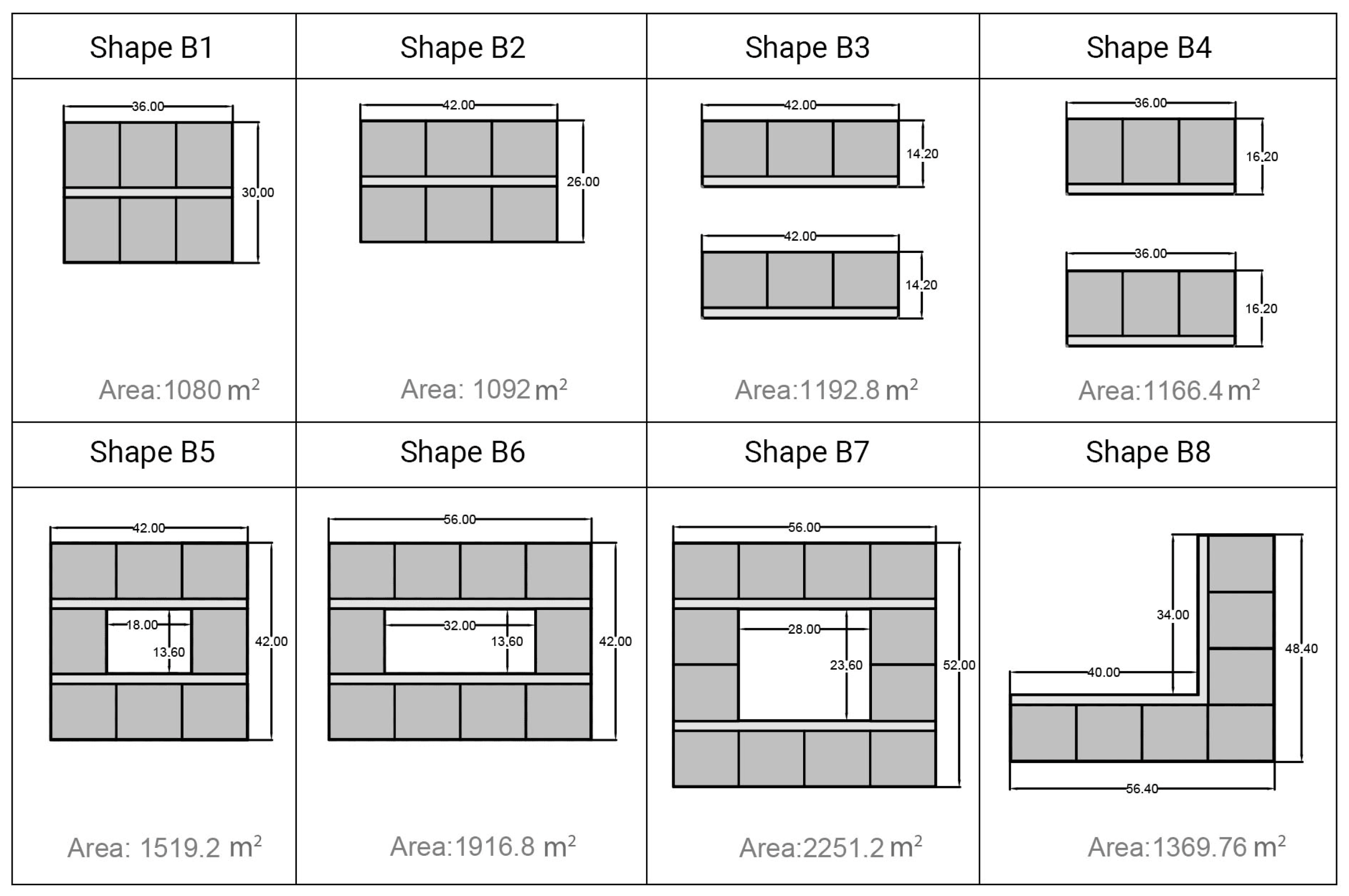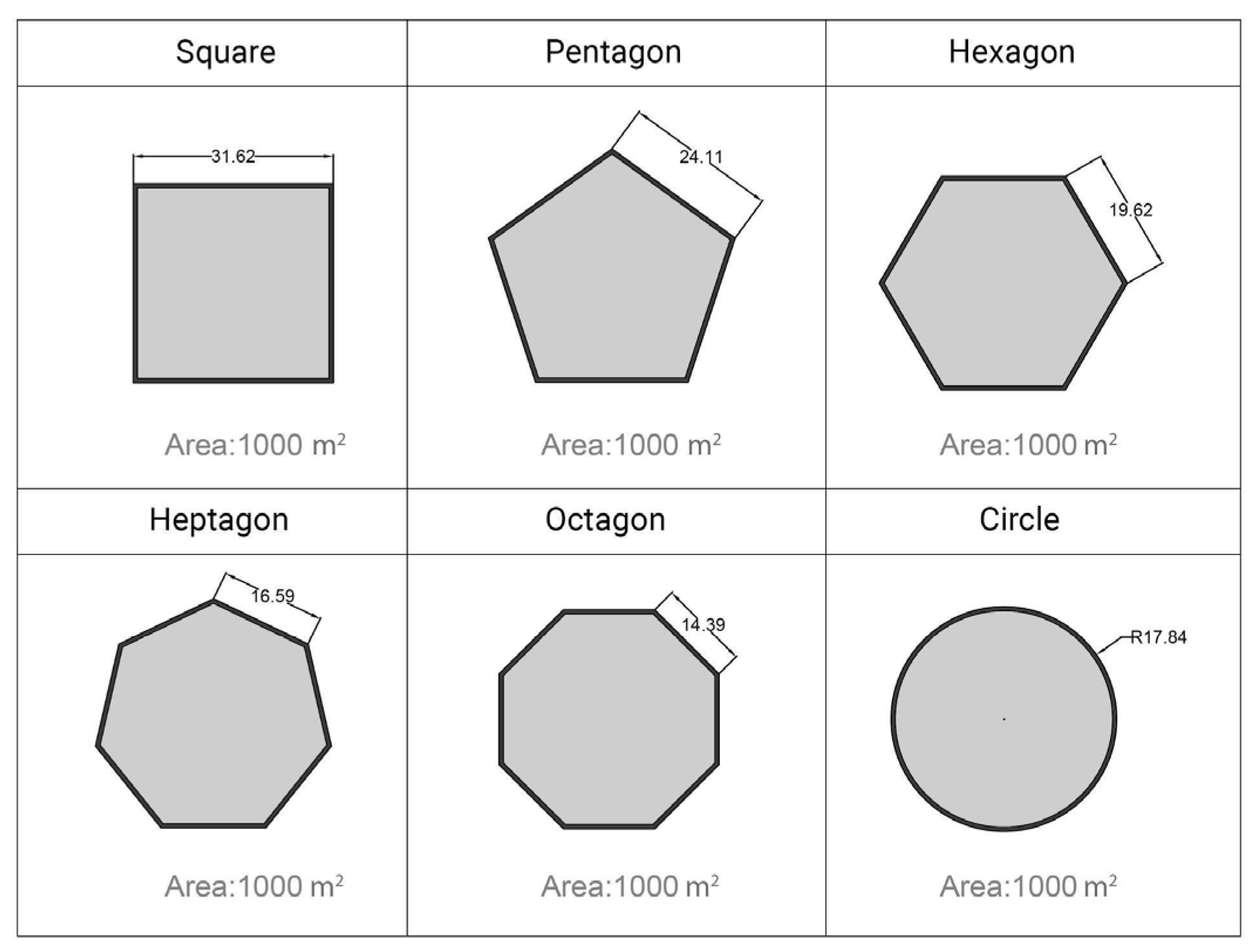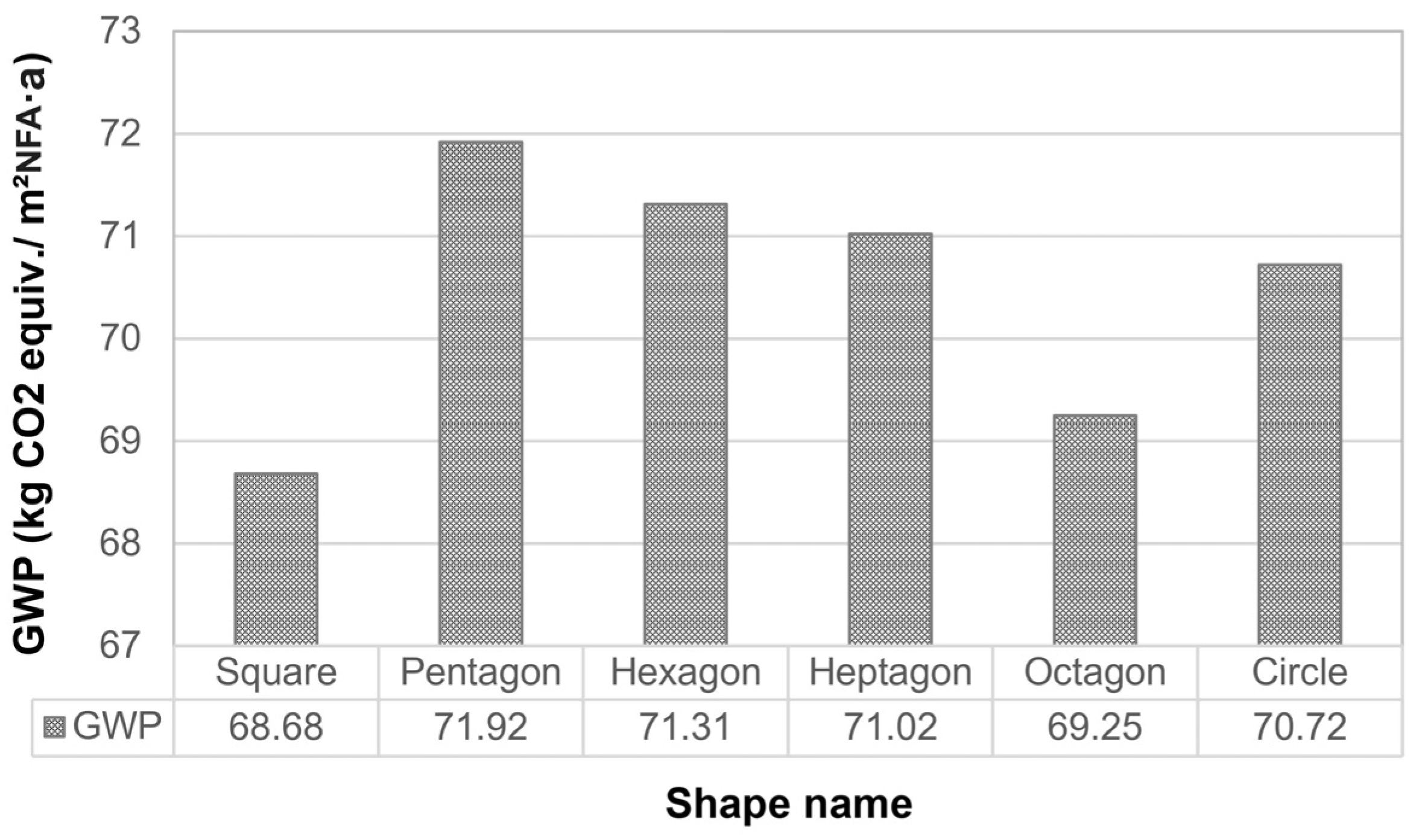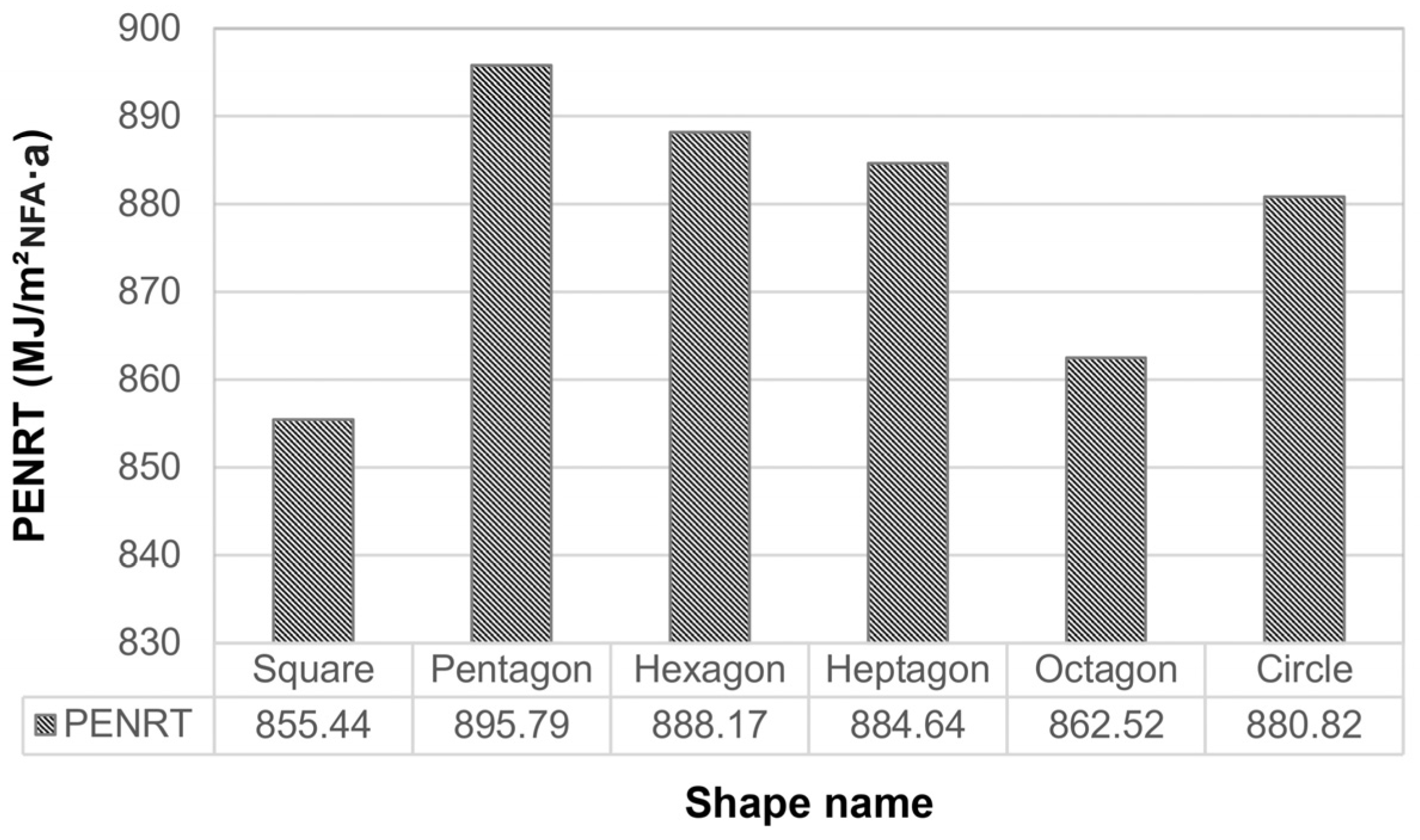An LCA Study of Various Office Building Shapes Focusing on Operational Energy—A Case of Hamburg
Abstract
1. Introduction
1.1. Background
1.2. Literature Review
1.3. Objectives of the Paper
2. Methodology
2.1. Selected Shapes of This Study
2.2. Energy Demand Calculation
2.2.1. Energy Demand for Heating and Hot Water
- Geographical context
- Shape-related factors
- Non-shape-related factors
2.2.2. Window-to-Wall Ratio (WWR)
2.2.3. Energy Demand for Artificial Lighting
2.3. LCA Calculation
3. Results
3.1. Heat Demand
3.2. Lighting Demand
3.3. Hot Water Demand
3.4. Total Energy Demand
3.5. Environmental Impacts
4. Discussion
5. Conclusions
Supplementary Materials
Author Contributions
Funding
Data Availability Statement
Conflicts of Interest
References
- Ma, M.; Zhou, N.; Feng, W.; Yan, J. Challenges and opportunities in the global net-zero building sector. Cell Rep. Sustain. 2024, 1, 100154. [Google Scholar] [CrossRef]
- Venkatraj, V.; Dixit, M.K.; Yan, W.; Lavy, S. Evaluating the impact of operating energy reduction measures on embodied energy. Energy Build. 2020, 226, 110340. [Google Scholar] [CrossRef]
- Optis, M.; Wild, P. Inadequate documentation in published life cycle energy reports on buildings. Int. J. Life Cycle Assess. 2010, 15, 644–651. [Google Scholar] [CrossRef]
- Dilsiz, A.D.; Felkner, J.; Habert, G.; Nagy, Z. Embodied versus operational energy in residential and commercial buildings: Where should we focus? J. Phys. Conf. Ser. 2019, 1343, 012178. [Google Scholar] [CrossRef]
- Nicholson, S.; Ugursal, V.I. A lifecycle assessment-based environmental analysis of building operationally energy efficient houses in Nova Scotia. J. Build. Eng. 2023, 76, 107102. [Google Scholar] [CrossRef]
- Hemmati, M.; Messadi, T.; Gu, H.; Hemmati, M. LCA Operational Carbon Reduction Based on Energy Strategies Analysis in a Mass Timber Building. Sustainability 2024, 16, 6579. [Google Scholar] [CrossRef]
- Asdrubali, F.; Baldassarri, C.; Fthenakis, V. Life cycle analysis in the construction sector: Guiding the optimization of conventional Italian buildings. Energy Build. 2013, 64, 73–89. [Google Scholar] [CrossRef]
- Hafner, A. Contribution of timber buildings on sustainability issues. In Proceedings of the World Sustainable Building 2014, Barcelona, Spain, 28–30 October 2014. [Google Scholar]
- Moayedi, F.; Zawawi, N.A.W.A.; Liew, M.S. Life Cycle Analysis of Operational Energy in Office Projects Toward Sustainability Practices in the Malaysian Construction Industry. Int. J. Eng. Technol. 2018, 7, 39. [Google Scholar] [CrossRef][Green Version]
- Grygierek, K.; Ferdyn-Grygierek, J. Analysis of the Environmental Impact in the Life Cycle of a Single-Family House in Poland. Atmosphere 2022, 13, 245. [Google Scholar] [CrossRef]
- Hester, J.; Miller, T.R.; Gregory, J.; Kirchain, R. Actionable insights with less data: Guiding early building design decisions with streamlined probabilistic life cycle assessment. Int. J. Life Cycle Assess. 2018, 23, 1903–1915. [Google Scholar] [CrossRef]
- Crawford, R.H.; Czerniakowski, I.; Fuller, R.J. A comprehensive model for streamlining low-energy building design. Energy Build. 2011, 43, 1748–1756. [Google Scholar] [CrossRef]
- Marsh, R. LCA profiles for building components: Strategies for the early design process. Build. Res. Inf. 2015, 44, 358–375. [Google Scholar] [CrossRef]
- Asadi, S.; Amiri, S.S.; Mottahedi, M. On the development of multi-linear regression analysis to assess energy consumption in the early stages of building design. Energy Build. 2014, 85, 246–255. [Google Scholar] [CrossRef]
- Yu, H.; Yang, W.; Li, Q.; Li, J. Optimizing Buildings’ Life Cycle Performance While Allowing Diversity in the Early Design Stage. Sustainability 2022, 14, 8316. [Google Scholar] [CrossRef]
- Basbagill, J.; Flager, F.; Lepech, M.; Fischer, M. Application of life-cycle assessment to early stage building design for reduced embodied environmental impacts. Build. Environ. 2013, 60, 81–92. [Google Scholar] [CrossRef]
- Meex, E.; Hollberg, A.; Knapen, E.; Hildebrand, L.; Verbeeck, G. Requirements for applying LCA-based environmental impact assessment tools in the early stages of building design. Build. Environ. 2018, 133, 228–236. [Google Scholar] [CrossRef]
- Hollberg, A.; Ruth, J. LCA in architectural design—A parametric approach. Int. J. Life Cycle Assess. 2016, 21, 943–960. [Google Scholar] [CrossRef]
- Monteiro, H.; Soares, N. Integrated life cycle assessment of a southern European house addressing different design, construction solutions, operational patterns, and heating systems. Energy Rep. 2022, 8, 526–532. [Google Scholar] [CrossRef]
- Van Den Dobbelsteen, A.; Thijssen, S.; Colaleo, V.; Metz, T.J. Ecology of the building geometry—Environmental performance of different building shape. In Proceedings of the CIB World Building Congress 2007, Cape Town, South Africa, 14–17 May 2007; Available online: https://iris.polito.it/handle/11583/1908680 (accessed on 15 November 2024).
- Serrano, A.Á.R.; Álvarez, S.P. Life Cycle Assessment in Building: A Case Study on the Energy and Emissions Impact Related to the Choice of Housing Typologies and Construction Process in Spain. Sustainability 2016, 8, 287. [Google Scholar] [CrossRef]
- Leskovar, V.Ž.; Žigart, M.; Premrov, M.; Lukman, R.K. Comparative assessment of shape related cross-laminated timber building typologies focusing on environmental performance. J. Clean. Prod. 2019, 216, 482–494. [Google Scholar] [CrossRef]
- Moschetti, R.; Mazzarella, L.; Nord, N. An overall methodology to define reference values for building sustainability parameters. Energy Build. 2014, 88, 413–427. [Google Scholar] [CrossRef]
- Pomponi, F.; Moncaster, A. Embodied carbon mitigation and reduction in the built environment—What does the evidence say? J. Environ. Manag. 2016, 181, 687–700. [Google Scholar] [CrossRef] [PubMed]
- Lotteau, M.; Loubet, P.; Sonnemann, G. An analysis to understand how the shape of a concrete residential building influences its embodied energy and embodied carbon. Energy Build. 2017, 154, 1–11. [Google Scholar] [CrossRef]
- Treloar, G.; Fay, R.; Ilozor, B.; Love, P. An analysis of the embodied energy of office buildings by height. Facilities 2001, 19, 204–214. [Google Scholar] [CrossRef]
- Foraboschi, P.; Mercanzin, M.; Trabucco, D. Sustainable structural design of tall buildings based on embodied energy. Energy Build. 2014, 68, 254–269. [Google Scholar] [CrossRef]
- Grossmann, I. Three scenarios for the greater Hamburg region. Futures 2005, 38, 31–49. [Google Scholar] [CrossRef]
- DIN V 18599-10:2018; Energy Efficiency of Buildings—Calculation of the Net, Final and Primary Energy Demand for Heating, Cooling, Ventilation, Domestic Hot Water and Lighting—Part 10: Boundary Conditions of Use, Climatic Data. Deutsches Institut für Normung e.V. (DIN e.V.): Berlin, Germany, 2018.
- DIN V 18599-4:2018; Energy Efficiency of Buildings—Calculation of the Net, Final and Primary Energy Demand for Heating, Cooling, Ventilation, Domestic Hot Water and Lighting—Part 4: Net and Final Energy Demand for Lighting. Deutsches Institut für Normung e.V. (DIN e.V.): Berlin, Germany, 2018.
- DIN V 18599-2:2018; Energy Efficiency of Buildings—Calculation of the Net, Final and Primary Energy Demand for Heating, Cooling, Ventilation, Domestic Hot Water and Lighting—Part 2: Net Energy Demand for Heating and Cooling of Building Zones. Deutsches Institut für Normung e.V. (DIN e.V.): Berlin, Germany, 2018.
- ELCA. Available online: https://www.bauteileditor.de/ (accessed on 15 November 2024).
- ÖKOBAUDAT Manual. Federal Institute for Research on Building, Urban Affairs and Spatial Development (BBSR). 2021. Available online: https://www.oekobaudat.de/fileadmin/downloads/2021-11-29_OEBD-Manual_v2.1.pdf (accessed on 15 November 2024).
- DIN EN 15978:2011; Sustainability of Construction Works—Assessment of Environmental Performance of Buildings—Calculation Method; German version EN 15978:2011. Deutsches Institut für Normung e.V. (DIN e.V.): Berlin, Germany, 2012.
- DIN EN 15804:2012-04; Sustainability of construction works—Environmental product declarations—Core rules for the product category of construction products; German version EN 5804:2012+A1:2013+A2:2019-10. Deutsches Institut für Normung e.V. (DIN e.V.): Berlin, Germany, 2020.
- BBSR. ÖKOBAUDAT. Available online: https://www.oekobaudat.de/ (accessed on 15 November 2024).
- Mumovic, D.; Santamouris, M. (Eds.) A Handbook of Sustainable Building Design and Engineering: An Integrated Approach to Energy, Health and Operational Performance; Earthscan: London, UK, 2013. [Google Scholar]
- Bre, F. Climate-Representative Locations According to the ASHRAE 169-2020 Climate Classification and Within the WMO Region VI (Europe) [Dataset]; Zenodo; CERN European Organization for Nuclear Research: Geneva, Switzerland, 2022. [Google Scholar] [CrossRef]
- Deutscher Wetterdienst. Klimareport Hamburg, Fakten bis zur Gegenwart—Erwartungen für die Zukunft; Deutscher Wetterdienst; Behörde für Umwelt, Klima, Energie und Agrarwirtschaft: Hamburg, Germany, 2021. [Google Scholar]
- Rana, J.; Hasan, R.; Sobuz, H.R.; Tam, V.W.Y. Impact assessment of window to wall ratio on energy consumption of an office building of subtropical monsoon climatic country Bangladesh. Int. J. Constr. Manag. 2020, 22, 2528–2553. [Google Scholar] [CrossRef]
- Troup, L.; Phillips, R.; Eckelman, M.J.; Fannon, D. Effect of Window-to-Wall Ratio on Measured Energy Consumption in US Office Buildings. Energy Build. 2019, 203, 109434. [Google Scholar] [CrossRef]
- Lahmar, I.; Cannavale, A.; Martellotta, F.; Zemmouri, N. The Impact of Building Orientation and Window-to-Wall Ratio on the Performance of Electrochromic Glazing in Hot Arid Climates: A Parametric Assessment. Buildings 2022, 12, 724. [Google Scholar] [CrossRef]
- Yu, Z.; Zhang, W.L.; Fang, T.Y. Impact of Building Orientation and Window-Wall Ratio on the Office Building Energy Consumption. Appl. Mech. Mater. 2013, 409–410, 606–611. [Google Scholar] [CrossRef]
- Ahmed, A.E.; Suwaed, M.S.; Shakir, A.M.; Ghareeb, A. The impact of window orientation, glazing, and window-to-wall ratio on the heating and cooling energy of an office building: The case of hot and semi-arid climate. J. Eng. Res. 2023; in press. [Google Scholar] [CrossRef]
- Shaeri, J.; Habibi, A.; Yaghoubi, M.; Chokhachian, A. The Optimum Window-to-Wall Ratio in Office Buildings for Hot-Humid, Hot-Dry, and Cold Climates in Iran. Environments 2019, 6, 45. [Google Scholar] [CrossRef]
- Ghisi, E.; Tinker, J.A. An Ideal Window Area concept for energy efficient integration of daylight and artificial light in buildings. Build. Environ. 2005, 40, 51–61. [Google Scholar] [CrossRef]
- Goia, F. Search for the optimal window-to-wall ratio in office buildings in different European climates and the implications on total energy saving potential. Sol. Energy 2016, 132, 467–492. [Google Scholar] [CrossRef]
- Ma, R.; Ma, R.; Long, E. Analysis of the rule of window-to-wall ratio on energy demand of residential buildings in different locations in China. Heliyon 2023, 9, e12803. [Google Scholar] [CrossRef] [PubMed]
- Hauschild, M.Z.; Rosenbaum, R.K.; Olsen, S.I. Life Cycle Assessment: Theory and Practice; Springer: Berlin/Heidelberg, Germany, 2017. [Google Scholar]







| Article | Year | Studied Shapes | Use | Study Criteria | Results Summery |
|---|---|---|---|---|---|
| [19] | 2022 | A southern European house with eight orientations, different window placements, four WWRs, and alternative building shapes such as a compact base case, a single-ground floor house, and a less compact two-story house | Residential | EE, OE, NRPE | In mild climates, the embodied energy of construction elements may represent most of the life cycle NRPE of houses |
| [20] | 2007 | Cube, slab, fence, warehouse, tower, and caterpillar | Office | Environmental costs of building components and energy consumption | Every floor area has an optimal number of stories in terms of environmental performance |
| [21] | 2016 | An urban layout comprising single and multifamily dwellings, characterized by distinct shapes of detached, semi-detached, terraced, slab-shaped, and H-shaped (with 4 and 2 yards and a compact version) | Residential | EE and CO2 emissions | Advantages of multi-family housing over single-family terraced housing, showcasing benefits in terms of both economic and ecological costs |
| [22] | 2018 | Cross-laminated timber building typologies of single-family houses: detached, two-story, three-story, semi-detached, and terraced buildings | Residential | Environmental performance of the building GWP, PENRT, AP | Linear correlation between the building shape and environmental performance |
| [23] | 2014 | Four types of Italian building typologies: single-family, terraced, multi-family, and apartment | Residential | Non-renewable energy, renewable energy, CC, TA, OD, ME, FE, POF | Varying indicator values for different shapes, with the pre-use and use phases being the dominant contributors compared to the end-of-life phase in most cases |
| [25] | 2017 | Concrete residential building variations in two urban forms; blocks and courts | Residential | EE and EC | Relation between the compactness and EE and EC levels, higher influence of buildings shape-related parameters on EE and EC levels than parameters related to the detailed composition of buildings functional elements |
| [26] | 2001 | Five office buildings of different heights in Melbourne | Office | EE | Building height dictates the amount of energy embodied in the structure group elements (upper floors, columns, internal walls, external walls and staircases) |
| [27] | 2014 | A reference building with six different heights | – | EE | The EE increases exponentially with building height due to material quantity (directly proportional) and structural premium for height, impacting wind and gravity load resisting systems |
| Month | Jan. | Feb. | March | April | May | June | July | Aug. | Sept. | Oct. | Nov. | Dec. |
|---|---|---|---|---|---|---|---|---|---|---|---|---|
| Average outside temperature (°C) | 2.5 | 2.7 | 4.9 | 8.5 | 12.8 | 15.5 | 17.8 | 17.8 | 14.1 | 9.8 | 5.1 | 2.3 |
| Month length (days) | 31 | 28 | 31 | 30 | 31 | 30 | 31 | 31 | 30 | 31 | 30 | 31 |
| Orientation | Month | |||||||||||
|---|---|---|---|---|---|---|---|---|---|---|---|---|
| Jan. | Feb. | March | April | May | June | July | Aug. | Sept. | Oct. | Nov. | Dec. | |
| North | 7 | 17 | 30 | 53 | 75 | 75 | 67 | 61 | 34 | 25 | 11 | 6 |
| East | 14 | 26 | 58 | 108 | 142 | 126 | 114 | 115 | 64 | 55 | 18 | 11 |
| South | 34 | 40 | 84 | 130 | 125 | 109 | 105 | 118 | 86 | 97 | 43 | 29 |
| West | 11 | 20 | 47 | 94 | 116 | 104 | 98 | 92 | 57 | 44 | 18 | 10 |
| Shape name | B1 | B2 | B3 | B4 | ||||||||
| Number of stories | 1 | 2 | 4 | 1 | 2 | 4 | 1 | 2 | 4 | 1 | 2 | 4 |
| Total floor area (m2) | 1080 | 2160 | 4320 | 1092 | 2184 | 4368 | 1192.8 | 2385.6 | 4771.2 | 1166.4 | 2332.8 | 4665.6 |
| Heat demand (kWh/m2·a) | 87.4 | 55.78 | 39.36 | 88.85 | 57.27 | 40.9 | 103.39 | 72.25 | 56.27 | 100.29 | 69.07 | 53.02 |
| Lighting demand (kWh/m2·a) | 30.28 | 30.28 | 30.28 | 29.51 | 29.51 | 29.51 | 24.69 | 24.69 | 24.69 | 26 | 26 | 26 |
| Hot water demand (kWh/m2·a) | 7.5 | 7.5 | 7.5 | 7.5 | 7.5 | 7.5 | 7.5 | 7.5 | 7.5 | 7.5 | 7.5 | 7.5 |
| Total energy demand (kWh/m2·a) | 125.19 | 93.56 | 77.14 | 125.86 | 94.28 | 77.91 | 135.59 | 104.45 | 88.47 | 133.8 | 102.58 | 86.53 |
| WFR | 0.1 | 0.1 | 0.1 | 0.12 | 0.12 | 0.12 | 0.22 | 0.22 | 0.22 | 0.19 | 0.19 | 0.19 |
| Form factor | 2.46 | 1.42 | 0.9 | 2.47 | 1.43 | 0.91 | 2.67 | 1.63 | 1.1 | 2.64 | 1.6 | 1.08 |
| Shape name | B5 | B6 | B7 | B8 | ||||||||
| Number of stories | 1 | 2 | 4 | 1 | 2 | 4 | 1 | 2 | 4 | 1 | 2 | 4 |
| Total floor area (m2) | 1519.2 | 3038.4 | 6076.8 | 1916.8 | 3833.6 | 7667.2 | 2251.2 | 4502.4 | 9004.8 | 1369.76 | 2739.52 | 5479.04 |
| Heat demand (kWh/m2·a) | 92.13 | 60.68 | 44.41 | 93.37 | 61.95 | 45.72 | 90.48 | 58.97 | 42.65 | 92.61 | 61.18 | 44.92 |
| Lighting demand (kWh/m2·a) | 29.35 | 29.35 | 29.35 | 28.38 | 28.38 | 28.38 | 29.68 | 29.68 | 29.68 | 29.1 | 29.1 | 29.1 |
| Hot water demand (kWh/m2·a) | 7.5 | 7.5 | 7.5 | 7.5 | 7.5 | 7.5 | 7.5 | 7.5 | 7.5 | 7.5 | 7.5 | 7.5 |
| Total energy demand (kWh/m2·a) | 128.99 | 97.54 | 81.26 | 129.26 | 97.84 | 81.61 | 127.66 | 96.16 | 79.83 | 129.22 | 97.78 | 81.52 |
| WFR | 0.12 | 0.12 | 0.12 | 0.14 | 0.14 | 0.14 | 0.11 | 0.11 | 0.11 | 0.12 | 0.12 | 0.12 |
| Form factor | 2.55 | 1.51 | 0.99 | 2.55 | 1.5 | 0.98 | 2.52 | 1.48 | 0.96 | 2.56 | 1.51 | 0.99 |
| Shape Name | Square | Pentagon | Hexagon | Heptagon | Octagon | Circle |
|---|---|---|---|---|---|---|
| Total floor area (m2) | 1000 | 1000 | 1000 | 1000 | 1000 | 1000 |
| Heat demand (kWh/m2·a) | 87.49 | 94.19 | 93.08 | 92.42 | 89 | 91.79 |
| Lighting demand (kWh/m2·a) | 30.73 | 29.94 | 29.93 | 30.09 | 30.26 | 30.16 |
| Hot water demand (kWh/m2·a) | 7.5 | 7.5 | 7.5 | 7.5 | 7.5 | 7.5 |
| Total energy demand (kWh/m2·a) | 125.72 | 131.64 | 130.52 | 130.01 | 126.76 | 129.45 |
| WFR | 0.09 | 0.19 | 0.18 | 0.17 | 0.13 | 0.17 |
| Form factor | 2.47 | 2.46 | 2.45 | 2.44 | 2.44 | 2.43 |
Disclaimer/Publisher’s Note: The statements, opinions and data contained in all publications are solely those of the individual author(s) and contributor(s) and not of MDPI and/or the editor(s). MDPI and/or the editor(s) disclaim responsibility for any injury to people or property resulting from any ideas, methods, instructions or products referred to in the content. |
© 2025 by the authors. Licensee MDPI, Basel, Switzerland. This article is an open access article distributed under the terms and conditions of the Creative Commons Attribution (CC BY) license (https://creativecommons.org/licenses/by/4.0/).
Share and Cite
Shokouhi, S.; Weidlich, I. An LCA Study of Various Office Building Shapes Focusing on Operational Energy—A Case of Hamburg. Sustainability 2025, 17, 1659. https://doi.org/10.3390/su17041659
Shokouhi S, Weidlich I. An LCA Study of Various Office Building Shapes Focusing on Operational Energy—A Case of Hamburg. Sustainability. 2025; 17(4):1659. https://doi.org/10.3390/su17041659
Chicago/Turabian StyleShokouhi, Samira, and Ingo Weidlich. 2025. "An LCA Study of Various Office Building Shapes Focusing on Operational Energy—A Case of Hamburg" Sustainability 17, no. 4: 1659. https://doi.org/10.3390/su17041659
APA StyleShokouhi, S., & Weidlich, I. (2025). An LCA Study of Various Office Building Shapes Focusing on Operational Energy—A Case of Hamburg. Sustainability, 17(4), 1659. https://doi.org/10.3390/su17041659







